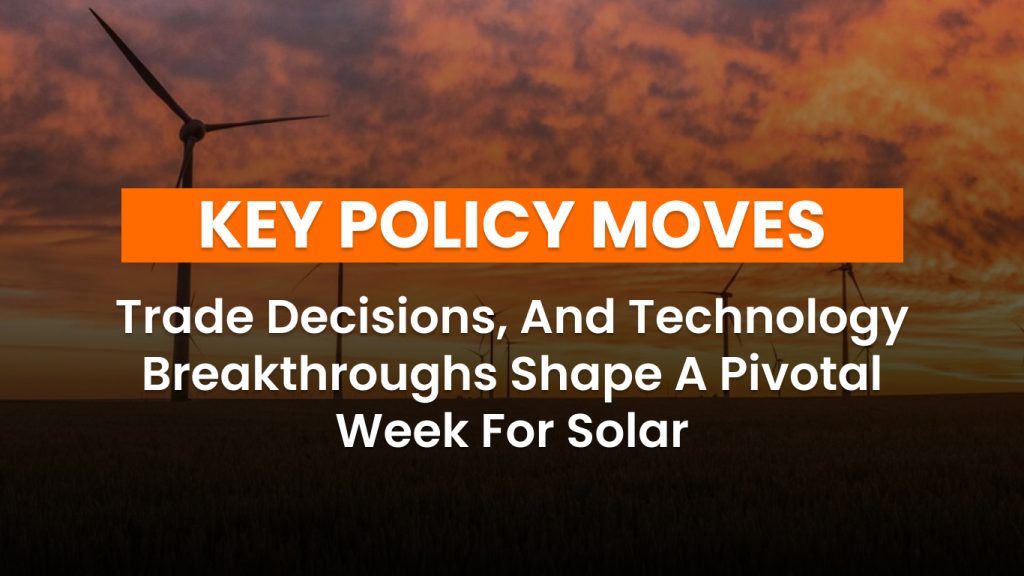This past week brought a wave of significant developments for the solar and broader renewable energy industries. From new U.S. legislation to breakthrough research in high-efficiency solar cells, the sector is navigating a mix of opportunities and fresh challenges. Here’s a look at the most important updates from May 19 through May 25, 2025.
New U.S. bill adds pressure to clean energy progress
A recent bill introduced in the U.S. legislature has raised concerns across the renewable energy landscape. The proposed policy includes stricter regulations and potential new tariffs on key clean energy components, particularly those used in solar and wind technologies. Industry analysts warn that the proposed measures could increase the cost of renewable energy projects and introduce significant delays, putting progress on emissions reduction targets at risk.
Clean energy advocates emphasize that these legislative changes may disrupt established supply chains and threaten job growth in the renewable sector. With project developers already navigating tight margins, any regulatory friction could dampen investor confidence and slow deployment. Stakeholders are urging lawmakers to reassess the bill’s provisions to ensure the country remains on track to meet its sustainable energy commitments.
U.S. finalizes tariffs on Southeast Asian solar imports
In a separate but related move, the U.S. International Trade Commission (ITC) finalized high tariffs on solar panel imports from four Southeast Asian countries: Cambodia, Malaysia, Thailand, and Vietnam. These duties, which will take effect in mid-June, come in response to findings that Chinese manufacturers were circumventing existing U.S. trade policies by routing products through these countries.
Tariffs will vary depending on the company, with some duties reaching as high as 3,403.96%. While the decision is aimed at protecting U.S.-based manufacturers and leveling the playing field, it could also lead to short-term price increases and supply disruptions. Solar developers and installers reliant on imported panels may now face steeper procurement costs, which could stall certain projects in the pipeline.
Tax credit transfers fuel growth in commercial solar
The U.S. commercial solar market saw record growth in 2024, with new capacity reaching 2.1 GWdc. This surge is largely attributed to the rise of third-party ownership models, which captured a 72% market share last year. A key driver behind this trend has been the flexibility of tax credit transfer provisions introduced under the Inflation Reduction Act.
These tax credit transfers have made it easier for third-party investors to monetize incentives, creating a more favorable environment for long-term financing. States like California and Illinois led in installations, and the trend is expected to continue through 2026 before gradually declining by 2029. The growth is seen as a win for commercial property owners and developers seeking to adopt clean energy without the burden of direct capital investment.
SolarPower Europe calls for stronger cybersecurity protections
In Europe, cybersecurity in the solar sector is under renewed scrutiny after a Danish investigation uncovered suspicious components in imported solar equipment. In response, SolarPower Europe is advocating for new EU-wide regulations to strengthen protections across the supply chain.
The industry group is calling for mandatory software transparency, limitations on remote access, and enhanced system integrity standards. With distributed energy resources playing an increasingly important role in national grids, the risk of cyberattacks targeting critical infrastructure has become a pressing concern.
EU Net-Zero Industry Act sets 40% local production requirement
To reduce dependence on non-European suppliers, the European Union has moved forward with implementing the Net-Zero Industry Act. Starting in 2026, member states will be required to produce at least 40% of their annual demand for essential clean energy technologies, including solar modules.
The Act includes new auction rules, sustainability criteria, and project eligibility guidelines designed to boost domestic manufacturing capacity. By supporting local supply chains, the EU hopes to strengthen energy security and competitiveness in the global renewable market.
Breakthrough in tandem solar cell efficiency
On the research front, a team at Zhejiang University has achieved a major milestone in tandem solar technology. Using a perovskite-TOPCon structure and a self-assembled monolayer (SAM), the researchers developed a tandem solar cell with a certified efficiency of 30.9%, peaking at 31.1% in lab settings.
This innovation significantly improves energy alignment and long-term stability, bringing high-efficiency solar cells closer to commercial viability. The breakthrough could pave the way for next-generation photovoltaic modules capable of surpassing the traditional efficiency limits of single-junction silicon cells.
As the global solar industry continues to grow, these updates reflect both the hurdles and advances shaping its future. From shifting trade policies to cutting-edge R&D, the coming months will be critical in determining how governments and markets respond to a rapidly evolving energy landscape.




